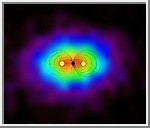|
COMETS EARTH JUPITER KUIPER BELT MARS MERCURY METEORITES NEPTUNE OORT CLOUD PLUTO SATURN SOLAR SYSTEM SPACE SUN URANUS VENUS ORDER PRINTS
PHOTO CATEGORIES SCIENCEVIEWS AMERICAN INDIAN AMPHIBIANS BIRDS BUGS FINE ART FOSSILS THE ISLANDS HISTORICAL PHOTOS MAMMALS OTHER PARKS PLANTS RELIGIOUS REPTILES SCIENCEVIEWS PRINTS
|
Related Document
Download Options
This image taken on January 4 and 5, 2001, by the ion and neutral mass spectrometer instrument on NASA's Cassini spacecraft makes the huge magnetosphere surrounding Jupiter visible in a way no instrument on any previous spacecraft has been able to do. The magnetosphere is a bubble of charged particles trapped within the magnetic environment of the planet. In this picture, a magnetic field is sketched over the image to place the energetic neutral atom emissions in perspective. This sketch extends in the horizontal plane to a width 30 times the radius of Jupiter. Also shown for scale and location are the disk of Jupiter (black circle) and the approximate position (yellow circles) of the doughnut-shaped torus created from material spewed out by volcanoes on Io, one of Jupiter's large moons. Some of the fast-moving ions within the magnetosphere pick up electrons to become neutral atoms, and once they become neutral, they can escape Jupiter's magnetic field, flying out from the magnetosphere at speeds of thousands of kilometers, or miles, per second. Cassini's instrument for imaging the magnetosphere builds an image from these atoms reaching the spacecraft, analagous to the way a normal camera builds an image from photons. Cassini is a cooperative mission of NASA, the European Space Agency and the Italian Space Agency. JPL, a division of the California Institute of Technology in Pasadena, manages Cassini for NASA's Office of Space Science, Washington, D.C. |
